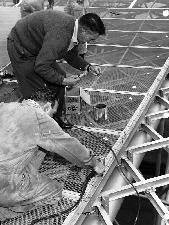
Photo CSIRO: John Bolton and Fox Mason resurfacing the dish in 1973.
 Photo CSIRO: John Bolton and Fox Mason resurfacing the dish in 1973. |
Congratulations:
Following the EVA and close out for the day, people at Parkes were finally able to relax with the knowledge that they had succeeded in what Clifford E. Charlesworth, the Apollo 11 Flight Director, described in a congratulatory telex as "the greatest television spectacular of all time".
The day following the EVA NASA handed over a cheque for $60,000. In 1973, with the Apollo missions completed, this money was used to upgrade the surface of the Parkes dish, giving it the capability to observe at higher frequencies.
Parkes was not required for the remainder of the Apollo 11 mission.
Following splashdown of Apollo 11 and the great success of the Parkes support, the Parkes Observatory was contracted by NASA to support all subsequent manned missions to the Moon.
Post Apollo 11:
Prior to Apollo 11, John Bolton and consultants Freeman Fox had been actively engaged in a study of the tower which had been recognised as seriously weak. With the memory of the Apollo 11 windstorm still fresh in his mind, Taffy Bowen decided that the tower had to be reinforced before the Apollo 12 mission in November 1969. Seven weeks of working two shifts a day saw the tower stiffened and major modifications made to the air conditioning (Goddard & Milne 1994). Jasper Wall relates:
Parkes was a station in the link between the Earth and the Apollo spacecraft for the Apollo 12, 14, 15, and 17 missions. It was brought into the Manned Space Flight Network when emergencies occurred in the flights of Apollo 13 and 16. (Bolton 1973).
In the early missions, tracking data from Houston was often hopelessly inaccurate and location of the spacecraft required an inspired guess plus a "square search". In the later missions the predictions improved, which was especially fortunate for Apollo 13.
With Apollo 13, Parkes actually played a vital role at critical phases of the rescue effort, which allowed the valuable and extremely weak telemetry signals from the command module Odyssey to be downlinked and the problems correctly diagnosed. But that's another story!